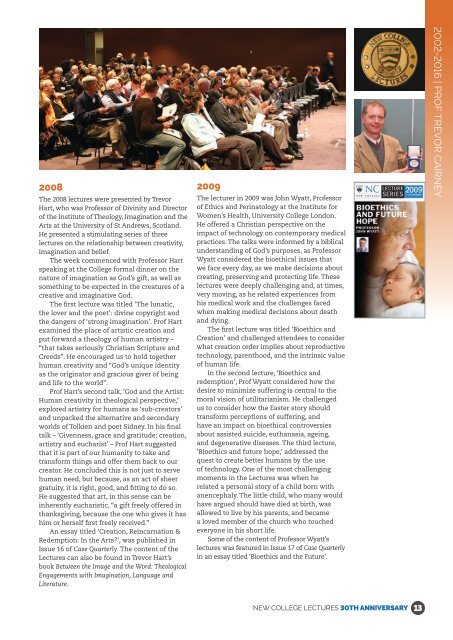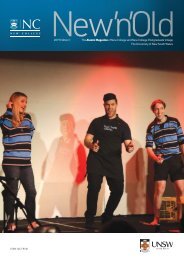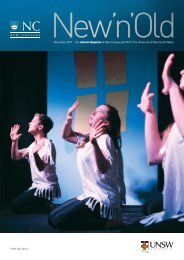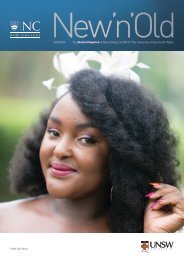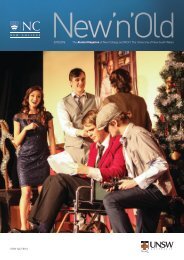Create successful ePaper yourself
Turn your PDF publications into a flip-book with our unique Google optimized e-Paper software.
2008<br />
The 2008 lectures were presented by Trevor<br />
Hart, who was Professor of Divinity and Director<br />
of the Institute of Theology, Imagination and the<br />
Arts at the University of St Andrews, Scotland.<br />
He presented a stimulating series of three<br />
lectures on the relationship between creativity,<br />
imagination and belief.<br />
The week commenced with Professor Hart<br />
speaking at the College formal dinner on the<br />
nature of imagination as God’s gift, as well as<br />
something to be expected in the creatures of a<br />
creative and imaginative God.<br />
The first lecture was titled ‘The lunatic,<br />
the lover and the poet’: divine copyright and<br />
the dangers of ‘strong imagination’. Prof Hart<br />
examined the place of artistic creation and<br />
put forward a theology of human artistry –<br />
“that takes seriously Christian Scripture and<br />
Creeds”. He encouraged us to hold together<br />
human creativity and “God’s unique identity<br />
as the originator and gracious giver of being<br />
and life to the world”.<br />
Prof Hart’s second talk, ‘God and the Artist:<br />
Human creativity in theological perspective,’<br />
explored artistry for humans as ‘sub-creators’<br />
and unpacked the alternative and secondary<br />
worlds of Tolkien and poet Sidney. In his final<br />
talk – ‘Givenness, grace and gratitude: creation,<br />
artistry and eucharist’ – Prof Hart suggested<br />
that it is part of our humanity to take and<br />
transform things and offer them back to our<br />
creator. He concluded this is not just to serve<br />
human need, but because, as an act of sheer<br />
gratuity, it is right, good, and fitting to do so.<br />
He suggested that art, in this sense can be<br />
inherently eucharistic, “a gift freely offered in<br />
thanksgiving, because the one who gives it has<br />
him or herself first freely received.”<br />
An essay titled ‘Creation, Reincarnation &<br />
Redemption: In the Arts?’, was published in<br />
Issue 16 of Case Quarterly. The content of the<br />
Lectures can also be found in Trevor Hart’s<br />
book Between the Image and the Word: Theological<br />
Engagements with Imagination, Language and<br />
Literature.<br />
2009<br />
The lecturer in 2009 was John Wyatt, Professor<br />
of Ethics and Perinatology at the Institute for<br />
Women’s Health, University College London.<br />
He offered a Christian perspective on the<br />
impact of technology on contemporary medical<br />
practices. The talks were informed by a biblical<br />
understanding of God’s purposes, as Professor<br />
Wyatt considered the bioethical issues that<br />
we face every day, as we make decisions about<br />
creating, preserving and protecting life. These<br />
lectures were deeply challenging and, at times,<br />
very moving, as he related experiences from<br />
his medical work and the challenges faced<br />
when making medical decisions about death<br />
and dying.<br />
The first lecture was titled ‘Bioethics and<br />
Creation’ and challenged attendees to consider<br />
what creation order implies about reproductive<br />
technology, parenthood, and the intrinsic value<br />
of human life.<br />
In the second lecture, ‘Bioethics and<br />
redemption’, Prof Wyatt considered how the<br />
desire to minimize suffering is central to the<br />
moral vision of utilitarianism. He challenged<br />
us to consider how the Easter story should<br />
transform perceptions of suffering, and<br />
have an impact on bioethical controversies<br />
about assisted suicide, euthanasia, ageing,<br />
and degenerative diseases. The third lecture,<br />
‘Bioethics and future hope,’ addressed the<br />
quest to create better humans by the use<br />
of technology. One of the most challenging<br />
moments in the Lectures was when he<br />
related a personal story of a child born with<br />
anencephaly. The little child, who many would<br />
have argued should have died at birth, was<br />
allowed to live by his parents, and became<br />
a loved member of the church who touched<br />
everyone in his short life.<br />
Some of the content of Professor Wyatt’s<br />
lectures was featured in Issue 17 of Case Quarterly<br />
in an essay titled ‘Bioethics and the Future’.<br />
2002-2016 | PROF TREVOR CAIRNEY<br />
NEW COLLEGE LECTURES 30TH ANNIVERSARY<br />
13


